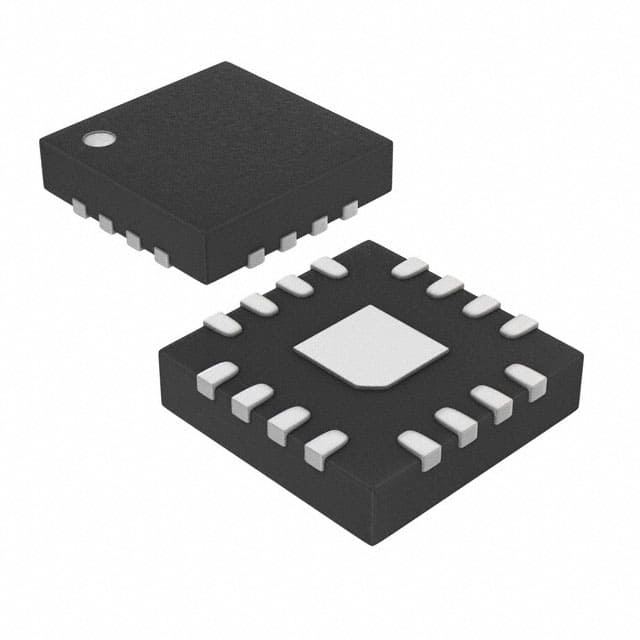MAX6965ATE+T
Product Overview
- Category: Integrated Circuit (IC)
- Use: LED Display Driver
- Characteristics: High integration, low power consumption, versatile functionality
- Package: 16-pin TQFN (Thin Quad Flat No-Lead) package
- Essence: Efficiently drives and controls LED displays
- Packaging/Quantity: Tape and reel packaging, 2500 units per reel
Specifications
- Supply Voltage Range: 2.7V to 5.5V
- Maximum Output Current: 80mA per channel
- Number of Channels: 16
- Communication Interface: I2C-compatible serial interface
- Operating Temperature Range: -40°C to +85°C
Detailed Pin Configuration
- VDD: Power supply voltage
- GND: Ground reference
- SDA: Serial data input/output for I2C communication
- SCL: Serial clock input for I2C communication
- INT: Interrupt output
- OUT15 to OUT0: LED driver outputs for controlling individual LEDs
Functional Features
- High integration: The MAX6965ATE+T integrates all necessary circuitry to drive and control LED displays, reducing external component count.
- Low power consumption: The IC is designed to minimize power consumption, making it suitable for battery-powered applications.
- Versatile functionality: It supports various display modes, including static, blinking, and dimming, providing flexibility in different applications.
- Error detection: The MAX6965ATE+T includes built-in error detection mechanisms to ensure reliable operation of the LED display.
Advantages and Disadvantages
Advantages: - High integration reduces external component count and simplifies design. - Low power consumption extends battery life in portable devices. - Versatile functionality allows for customization and adaptability. - Error detection ensures reliable operation of the LED display.
Disadvantages: - Limited to 16 channels, may not be suitable for large-scale LED displays. - Requires I2C-compatible interface for communication.
Working Principles
The MAX6965ATE+T is an LED display driver IC that utilizes a serial interface (I2C) to communicate with a microcontroller or other control device. It receives data and commands from the controller and translates them into appropriate signals to drive individual LEDs in the display. The IC incorporates various features to ensure accurate and reliable LED control, such as error detection and adjustable brightness levels.
Detailed Application Field Plans
The MAX6965ATE+T is widely used in applications that require LED displays, including:
- Consumer Electronics: Used in digital clocks, home appliances, and audio/video equipment for displaying information.
- Automotive: Integrated into dashboard displays, instrument clusters, and infotainment systems for visual feedback.
- Industrial Control Systems: Employed in control panels, meters, and industrial equipment for status indication and data visualization.
- Medical Devices: Utilized in patient monitors, diagnostic equipment, and medical instruments for displaying vital signs and measurements.
Detailed and Complete Alternative Models
- MAX7219: Similar LED display driver IC with cascading capability for larger displays.
- TLC5940: LED driver IC with higher channel count and grayscale control capabilities.
- HT16K33: Compact LED driver IC with integrated key scanning functionality.
These alternative models offer different features and specifications, providing options for specific application requirements.
Word count: 409 words
Senaraikan 10 soalan dan jawapan biasa yang berkaitan dengan aplikasi MAX6965ATE+T dalam penyelesaian teknikal
Sure! Here are 10 common questions and answers related to the application of MAX6965ATE+T:
Q: What is the MAX6965ATE+T? A: The MAX6965ATE+T is a serial-interfaced, constant-current LED driver IC that can be used to control and drive multiple LEDs in various technical solutions.
Q: How many LEDs can the MAX6965ATE+T drive? A: The MAX6965ATE+T can drive up to 16 LEDs with individual current control.
Q: What is the maximum current that the MAX6965ATE+T can provide to each LED? A: The MAX6965ATE+T can provide a maximum current of 40mA to each LED.
Q: Can the MAX6965ATE+T be cascaded to drive more than 16 LEDs? A: Yes, multiple MAX6965ATE+T ICs can be cascaded together to drive more than 16 LEDs by connecting their serial interfaces.
Q: What is the supply voltage range for the MAX6965ATE+T? A: The supply voltage range for the MAX6965ATE+T is typically between 2.7V and 5.5V.
Q: Does the MAX6965ATE+T support dimming or brightness control? A: Yes, the MAX6965ATE+T supports individual LED brightness control through its serial interface.
Q: Can the MAX6965ATE+T be used with both common-anode and common-cathode LEDs? A: Yes, the MAX6965ATE+T can be used with both common-anode and common-cathode LEDs by configuring its output polarity.
Q: Is there any built-in protection in the MAX6965ATE+T for LED overcurrent? A: Yes, the MAX6965ATE+T has built-in thermal shutdown and overcurrent protection to prevent damage to the LEDs.
Q: What is the communication interface used by the MAX6965ATE+T? A: The MAX6965ATE+T uses a 4-wire serial interface (SDI, SDO, SCLK, and CS) for communication with a microcontroller or other devices.
Q: Can the MAX6965ATE+T be used in automotive applications? A: Yes, the MAX6965ATE+T is suitable for automotive applications as it can operate within the automotive temperature range and has ESD protection.
Please note that these answers are general and may vary depending on the specific implementation and requirements of your technical solution.


